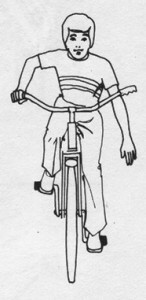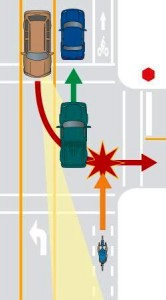Bicycle Riding for Fun and Safety
Riding a bicycle. Feeling the wind blow across your face and being able to take in the sights, smells and sounds around you has always been a fun adventure.
Riding a bicycle is also dangerous and should be taken seriously.
When you are riding a bike on the roadways, you are simply another vehicle. Unfortunately, you are a vehicle with little protection and one difficult to see.
So, how can you enjoy a ride and still exercise a level of safety? There are some basic things to remember:
Always wear a helmet. If something as simple as this can prevent or minimize head injuries, why would you not wear a helmet?
Control your bicycle. This seems like “biking 101”, but it is surprising how many people have only moderate bicycle handling skills. You would not go out on the roadway on a motorcycle or car without practice…lots of practice, so why go out on a bike without the same caution? Go to an area where there is no fear of traffic and practice riding, swerving, stopping and turning until you are completely comfortable.


Learn and follow the rules of the road. When you are travelling down a public roadway on a bicycle, you are simply another vehicle. You are obligated to understand and follow the rules of the road. In today’s urban areas, you may be provided a bike lane, but your obligations to signal, stop at traffic control devices and to watch for hazards is no different than if you were driving a car down the street.
Follow proper lane positioning techniques. It is important where you locate yourself within a lane. When to use the full lane and when to try and share a lane can mean the difference between a driver in a motor vehicle seeing you or being able to pass you safely. Ride a little further left so that a passing vehicle can better see you as they approach from the rear. Most riders have a tendency to want to hug the right curb or berm area, but this actually makes you more difficult to see since most drivers are not looking toward the right side of the road and this position allows you a reduced escape area should you need it.
Practice hazard avoidance skills. Go to a vacant parking lot area or similar place with space and no traffic. Practice quick stops, quick turns and dodging obstacles. Learn to safely dismount from your bike while moving. None of these skills are instinctual and they all require practice.
Think about common crash scenarios and consider ways to avoid or respond to them:
- Motorist pulls out from a side street or driveway.
- A left cross in which the driver turns left into or in front of you.
- Side swipe in which the vehicle driver tries to squeeze between the cyclist and the center-line, median or other traffic markings. Ride to the left a little to discourage drivers from this.
- Right-hook in which a driver makes a right hand turn in front of you, through the bike lane.
- Welcome door in which a driver opens the door of their parked vehicle right into the path of your bike, without looking in their side view mirror.
- Watch for blind spots especially at intersections. A car turning left may not see you clearly if your bike is positioned at the rear right edge of a truck or car.
Distracted driving on a bicycle is no different than it is in a car, truck or motorcycle. Focus on the task at hand. Eliminate cell phones, music players and all other distractions. Remember that “multi-tasking” is a myth and one that, while riding a bike, could prove to be deadly.
Know and follow the laws. In Florida, most of the bicycle regulations are covered under Florida Statutes Section 316.2065 and they provide, in summary:
- A bicyclist has all the rights and duties as does the driver of any vehicle on the roadway.
- Your bike must have a “permanent and regular seat attached” to it.
- No more than one person at a time may ride a single bicycle; except a child securely attached in a backpack or a seat/carrier designed to carry a child and protects the child from the moving parts of the bike.
- A bicycle rider or passenger under the age of 16 years must wear a bicycle helmet properly fitted and which meets the standards set forth by the American National Standards Institute (1984).
- No person riding a bike may attach themselves to a vehicle upon a roadway.
- People riding upon a roadway may not ride more than two abreast and only then if they do not impede traffic.
- Bike riders must maintain at least one hand upon the handlebars at all times.
- Any bike in use between sunset and sunrise must be equipped with a white light ion the front, which is visible at least 500 feet to the front of the bicycle and a reflector on the rear visible from a distance of at least 600 feet.
So, when riding a bike, exercise caution, good sense and always keep safety in mind. You are simply another vehicle upon the roadway with all the rights, but also all the duties and obligations of any other vehicle.
Share This




